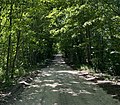| This article needs additional citations for verification. Please help improve this article by adding citations to reliable sources. Unsourced material may be challenged and removed. Find sources: "Dirt road" – news · newspapers · books · scholar · JSTOR (December 2022) (Learn how and when to remove this message) |

A dirt road or track is a type of unpaved road not paved with asphalt, concrete, brick, or stone; made from the native material of the land surface through which it passes, known to highway engineers as subgrade material.
Terminology
Similar terms
Terms similar to dirt road are dry-weather road, earth road, or the "Class Four Highway" designation used in China. A track, dirt track, or earth track would normally be similar but less suitable for larger vehicles—the distinction is not well-defined. Laterite and murram roads, depending on material used, may be dirt roads or improved roads.
Improved road
Unpaved roads with a harder surface made by the addition of material such as gravel and aggregate (stones), might be referred to as dirt roads in common usage but are distinguished as improved roads by highway engineers. Improved unpaved roads include gravel roads and macadamized roads.
Characteristics
Compared to a gravel road, a dirt road is not usually graded regularly to produce an enhanced camber to encourage rainwater to drain off the road, and drainage ditches at the sides may be absent. They are unlikely to have embankments through low-lying areas. This leads to greater waterlogging and erosion, and after heavy rain the road may be impassable even to off-road vehicles. For this reason, in some countries, such as Australia and New Zealand and Finland, they are known as dry-weather roads.

Dirt roads take on different characteristics according to the soils and geology where they pass, and may be sandy, stony, rocky or have a bare earth surface, which could be extremely muddy and slippery when wet, and baked hard when dry. They are likely to become impassable after rain. They are common in rural areas of many countries, often very narrow and infrequently used, and are also found in metropolitan areas of many developing countries, where they may also be used as major highways and have considerable width.
Dirt roads almost always form a washboard-like surface with ridges. The reason for this is that dirt roads have tiny irregularities; a wheel hitting a bump pushes it forward, making it bigger, while a wheel pushing over a bump pushes dirt into the next bump. However, the surface can remain flat for velocities less than 5 mph (8 km/h).
Driving on dirt roads
While most gravel roads are all-weather roads and can be used by ordinary cars, dirt roads may only be passable by trucks or four-wheel drive vehicles, especially in wet weather, or on rocky or very sandy sections. It is as easy to become bogged in sand as it is in mud; a high clearance under the vehicle may be required for rocky sections.
Driving on dirt roads requires great attention to variations in the surface and it is easier to lose control than on a gravel road.
Image gallery
-
 Dirt road in Fremont, California
Dirt road in Fremont, California
-
 Wrightwood Street in Lincoln Park neighborhood of Chicago, Illinois, c. 1880
Wrightwood Street in Lincoln Park neighborhood of Chicago, Illinois, c. 1880
-
 Mountain track in Switzerland
Mountain track in Switzerland
-
 Detail of a dry, loamy road
Detail of a dry, loamy road
-
 Cycling on a rough road in Tanzania
Cycling on a rough road in Tanzania
- Spraying dirt road with water in Benin
-
 Rural dirt road near Kingsley, Michigan
Rural dirt road near Kingsley, Michigan
-
 Dirt road in Brazil
Dirt road in Brazil
References
- Sultana, Selima; Weber, Joe (2016-04-18). Minicars, Maglevs, and Mopeds: Modern Modes of Transportation Around the World: Modern Modes of Transportation around the World. ABC-CLIO. ISBN 978-1-4408-3495-0.
- "Road Bumps: Why dirt roads develop a washboard surface". 2007-08-15. Retrieved 2022-12-06.